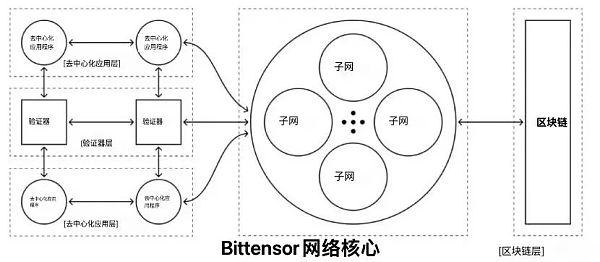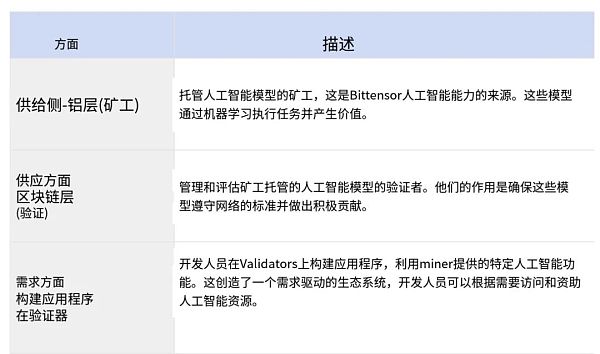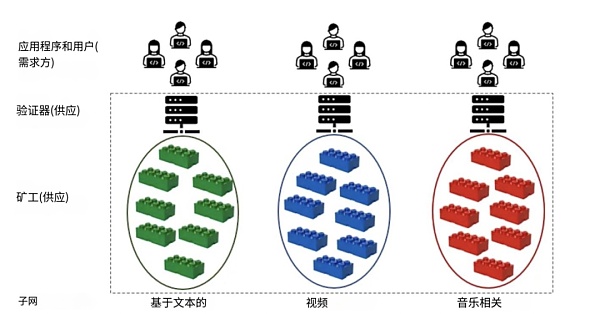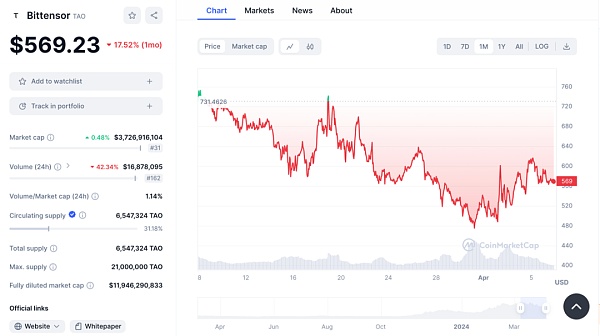1. Project Introduction

Bittensor is a decentralized protocol focused on AI and machine learning, at the forefront of decentralized artificial intelligence (AI). By using blockchain technology, BitTensor aims to solve some of the core problems encountered in the development of traditional AI, such as data ownership, incentive mechanisms for model training, and accessibility of AI services.
Currently, training machine learning models requires a lot of resources, which are usually only affordable by large companies such as Google and OpenAI. In response, Bittensor aims to decentralize the access and training of machine learning models and operate in a censorship-resistant manner. Decentralized machine learning models prevent similar models trained by different companies from being trained in isolated islands, promote the compounding and composability of openly developed AI models, and accelerate the development of the AI field.
Bittensor's AI ecosystem is powered by its native token $TAO: rewards contributions through $TAO tokens, promotes cooperation, and protects the blockchain ecosystem. One of its features is a dedicated subnet structure. These subnets are where real value is created through competition and cooperation. Bittensor encourages innovation through this structure and promises inclusiveness and quality.
Bittensor's token economy (Tokenomics) is designed to encourage fair distribution practices and ensure incentive alignment among network participants. The TAO token is designed to grow exponentially as the base of network participants expands. Currently, approximately 89% of the circulating TAO tokens are currently staked, which also reflects the high participation of the network. 2. Core Mechanisms Network Ecosystem Dynamics Bittensor’s ecosystem thrives on its unique subnet dynamics, each of which offers rewards tailored to a variety of AI applications. This setup showcases diversity and innovation, an area that many large AI companies may overlook. A single TAO token ecosystem supports these activities, giving token owners a large say in how AI develops in the network.

Bittensor machine learning methods and mechanisms
Bittensor connects several key types of participants in its network:
Miner layer: is the core of AI-driven innovation within Bittensor, miners host and run various AI models.
Validator layer: plays a key role in maintaining the integrity and consensus of the blockchain, ensuring that the network operates according to established rules.
Enterprise layer: is committed to developing cutting-edge applications that use the network's AI capabilities to solve complex problems.
Consumer Layer: Provides end users and organizations with access to solutions and services generated by the network.
This enables secure and efficient collaboration between blockchain operations and AI services.


Decentralised Mixture Of Experts (MoE)
In addition, Bittensor adopts a decentralized mixture of experts (MoE) model to improve the accuracy and efficiency of AI predictions through the collaboration of multiple professional AI models. This approach combines the unique advantages of each model to solve complex problems, thereby achieving more precise and comprehensive results, surpassing the traditional single model approach. For example, when generating Python code with Spanish comments, the language capabilities of one model and the coding expertise of another model merge to provide a superior solution.

Proof Of intelligence
Proof of intelligence is a way for the Bittensor network to reward nodes that add useful machine learning models and results. It is similar to the way blockchain networks use PoW and PoS, but instead of solving math puzzles, nodes perform machine learning tasks to demonstrate their intelligence. If a node's machine learning work is accurate and valuable, it has a better chance of being selected to add new blocks to the chain and earn TAO tokens as a reward. In order to receive rewards in the Bittensor network, servers must not only produce valuable knowledge, but also be recognized by the majority of validators. By adopting this consensus mechanism, Bittensor incentivizes valuable contributions, promotes collaboration, and protects the blockchain.
3. Tao
The TAO token is the native cryptocurrency of the Bittensor network. It serves several key functions and purposes in the ecosystem:
Incentives: TAO tokens are used to incentivize various participants in the Bittensor network. Miners who contribute computing resources to perform machine learning tasks are rewarded with TAO tokens for their contributions. This reward mechanism encourages the provision of computing power to the network, which is critical to the decentralized machine learning process.
Staking: To participate in the network as a miner and receive rewards, participants must stake TAO tokens. Staking, as a form of collateral or "skin in the game," helps ensure that miners are incentivized to act in the best interest of the network. It also makes malicious behavior by any participant costly, thereby helping to secure the network.
Governance: TAO tokens can be used for governance of the Bittensor network. Token holders may have the ability to propose changes, vote on protocol upgrades, or participate in other decision-making processes that affect the network. This is consistent with the decentralized ethos of blockchain technology, where control is distributed among stakeholders rather than concentrated in a single institution.
Transaction Fees: Transactions on the Bittensor network, such as token transfers or the execution of smart contracts, may require fees. These fees are typically paid in TAO tokens and are used to compensate validators and miners for processing and securing transactions on the blockchain.
Economic Model: TAO tokens underpin the economic model of the Bittensor network. It is designed to balance the supply and demand of computing resources, align incentives between participants, and facilitate value exchange within the ecosystem.
Access Services: Users who require machine learning services provided by the Bittensor Network may need to pay for these services using TAO tokens. This creates a market for machine learning services where tokens can be exchanged for computational work, such as data analysis, model training, or predictions.
The TAO token is integral to the functionality of the Bittensor Network as it provides the economic and incentive structure that supports a decentralized machine learning market, aligning the interests of various stakeholders through token-based incentives.
As of now, the current price of the TAO token is $568.38 USD. Its market cap is $3,721,338,889 USD, ranking 31st. TAO is a larger crypto asset with a significant market share. Its 24-hour volume/market cap ratio: 1.14%, which is a relatively active market, indicating that the volume traded on a daily basis accounts for a small portion of the total market cap. Its circulating supply: 6,547,324 TAO, accounting for 31.18% of the total supply. This shows that more than one-third of the maximum supply is being traded or held in the market. TAO's maximum supply is 21,000,000 TAO, which is a fixed supply cap designed to prevent inflation and may increase scarcity over time. The fully diluted market value is $11,936,827,522, and if all TAOs are calculated at current prices, the market value will reach nearly $12 billion.


TAO also halves every four years like Bitcoin. Once half of the total supply is issued, the issuance rate will be halved. With one block mined every 12 seconds, this equates to a halving event approximately every four years. Each subsequent halving event will occur at intervals corresponding to half of the remaining TAO to be issued, until the full supply of 21 million TAO enters circulation.

If you want to buy TAO, you can do so through MEXC, Bitget, Gate.io, and Kucoin. TAO can also be purchased through the decentralized exchange Kujira Fin.
4. Team/Funding
Bittensor has an excellent team behind it. According to LinkedIn, the company has a total of 14 employees. Some have PhDs in physics and artificial intelligence. Most members of the team have backgrounds and experience in computer science, artificial intelligence, and engineering.
The co-founders of Bittensor are Jacob Steeves and Ala Shaabana. Jacob Steeves is the CEO and co-founder of Bittensor. He has a background in machine learning research and founded Bittensor to decentralize artificial intelligence. He also worked at Google for a few years. Ala Shaabana is the COO and co-founder of Bittensor. He has a Ph.D. in machine learning.
So far, it is known that Bittensor has completed three rounds of financing: Series A: Bittensor completed its Series A financing on May 12, 2021. The amount was not disclosed and marked as "confidential"; Early venture capital: Bittensor has also completed other unspecified early venture capital rounds; Accelerator/Incubator: Bittensor also completed a round of accelerator/incubator program on January 1, 2021, the details of which are again marked as "confidential".
Bittensor's investors include venture capital firms such as Collab+Currency, Gravity Fund, NGC Ventures, Oss Capital and Creative Destruction Lab, which shows that diverse supporters believe in the company's mission.
5. The Future of TAO and Bittensor
Utility Expansion, Network Growth, and Ecosystem Development
As Bittensor’s native token, TAO plays a central role in the network’s economy. As the Bittensor network grows, TAO’s utility may expand beyond simple transactions to include governance, staking, and access to premium services, which could increase its value and demand.
If Bittensor succeeds in attracting more miners and users, the increase in activity on the network could lead to a higher valuation for TAO due to increased usage.
Developing additional services and applications on top of Bittensor could create an ecosystem where TAO is used for a variety of AI-related services, further integrating it into the AI and blockchain markets.
Research and Innovation
TAO can be used to fund research and innovation within the Bittensor network, driving advancements in AI and blockchain technology, thereby increasing the value of the token.
Global AI Marketplace
If Bittensor becomes a global marketplace for AI services, TAO could become the standard currency for AI transactions, just as Bitcoin became synonymous with cryptocurrency.
Regulatory Compliance
As AI and blockchain regulations evolve, TAO’s design could adapt to these new standards, potentially making it a more stable and reliable asset.
Partnerships and Integrations
Strategic partnerships with other blockchain networks, data providers, and AI companies could lead to broader use cases for TAO and integration into other platforms.
6. Conclusion
In summary, the convergence of AI and blockchain technology (exemplified by networks such as Bittensor) has the potential to create a more open, transparent, and collaborative AI environment. As Bittensor’s native token, TAO’s future potential depends on the network’s ability to foster a strong ecosystem where AI models can be trained, shared, and used in a secure and decentralized manner.
As Bittensor and similar platforms grow, they could have a significant impact across industries by enabling smaller entities to compete with larger organizations in their use of cutting-edge AI tools. Furthermore, the use of TAO could incentivize the continued improvement and deployment of AI models, fostering a cycle of innovation and adoption.
TAO’s success could depend on several factors, including the scalability of the Bittensor network, ease of use for miners and consumers of AI services, the network’s ability to ensure the quality and reliability of AI outputs, and the overall adoption of blockchain and AI technologies across different sectors.
If Bittensor can meet these challenges and capitalize on the opportunities presented by the convergence of AI and blockchain, TAO could become a key asset in the emerging field of decentralized AI services. This would not only increase the value of TAO as a token, but also position Bittensor as a key player in shaping the future of AI and blockchain integration.
 JinseFinance
JinseFinance














